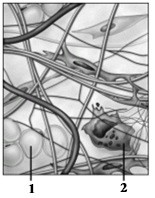Glands whose ducts have no branches are called ________.
A. alveolar
B. acinar
C. branchless
D. simple
E. compound
Answer: D
You might also like to view...
The placenta allows
A. carbon dioxide and other wastes to diffuse from the maternal blood to the embryonic blood. B. oxygen and nutrients to diffuse from maternal blood to the embryo. C. maternal blood to mix with fetal blood. D. the fetus to enlarge without rupturing the mother's abdomen.
Axial muscles fall into logical groups based upon
A) location and function. B) location. C) muscle structure. D) function. E) None of the answers are correct.
 In this image showing connective tissue components, what structure does number 2 indicate?
In this image showing connective tissue components, what structure does number 2 indicate?
A. Fibroblast B. Extracellular matrix C. Adipocyte D. Macrophage E. Mesenchymal cell
What prevents an action potential from moving backward along the axon? In other words, why do action potentials move in one direction only, down the axon away from the cell body?
A. The refractory period prevents the action potential from moving backward. B. Myelin sheaths prevent the action potential from moving backward. C. In some axons, action potentials do move backward.